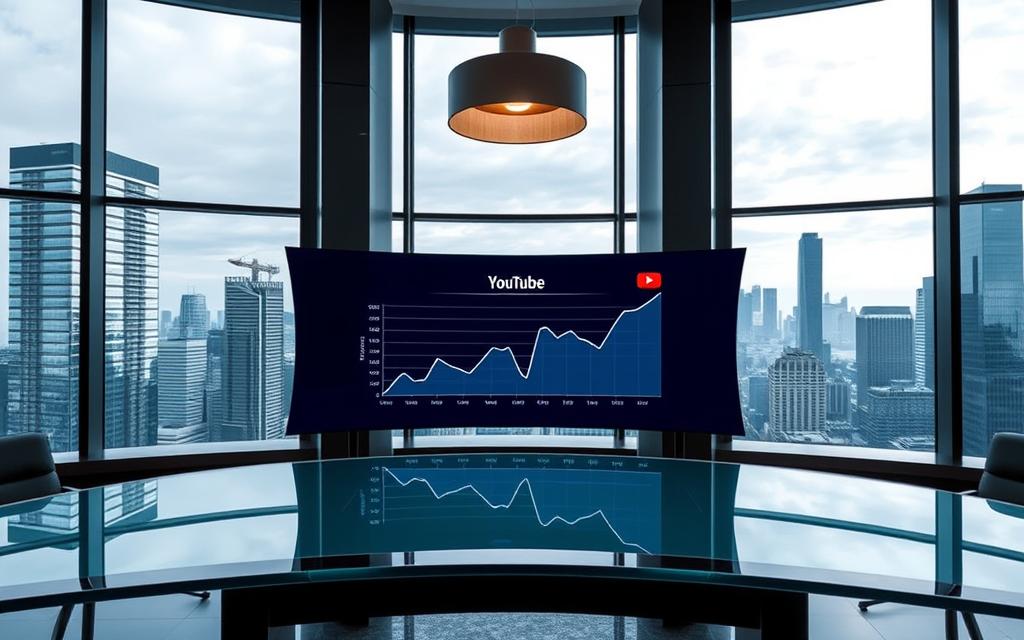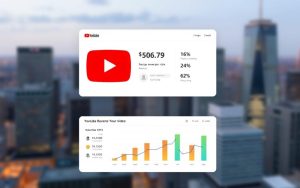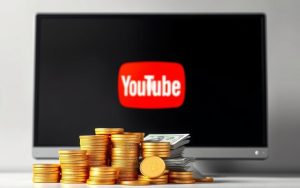Table of Contents
Earnings from YouTube vary widely, and there’s no fixed rate for creators. Reports suggest payouts for 1 million views range between $3,000 and $30,000. Factors like niche, audience location, and engagement heavily influence revenue.
For example, vidIQ’s 18-month experiment revealed earnings of $3,231.42 for long-form content. Meanwhile, AIR Media-Tech boosted income by optimizing ad breaks. These cases highlight the unpredictability of YouTube revenue.
Regional CPM differences, ad formats, and viewer demographics play key roles. High-engagement niches like finance or tech often yield better returns. Understanding these variables helps creators set realistic expectations.
How Much Money Is 1 Million Views on YouTube? (The Short Answer)
Behind every million-view milestone lies a complex payout structure. On average, creators earn $3,000–$5,000 for 1M views, but top-performing channels can reach $30,000. The exact amount hinges on metrics like *RPM* (Revenue Per Mille) and *CPM* (Cost Per Mille).
For example, vidIQ’s experiment showed a $13.29 CPM—meaning advertisers paid $13.29 per 1,000 impressions. This metric often matters more than raw views. A finance creator might earn $24,592 per million views, while gaming channels typically net $1,000–$5,000.
YouTube takes a 45% cut of ad revenue, and creators must meet YouTube Partner Program requirements. Stars like Mr. Beast showcase how diversifying with sponsorships and merch boosts earnings beyond ads.
Key takeaways:
- Earnings per view average $0.003–$0.005.
- High-CPM niches (e.g., finance) outperform others.
- RPM reflects actual earnings after YouTube’s share.
Understanding YouTube Monetization Basics

Monetizing content on YouTube starts with understanding its foundational systems. The platform’s revenue model hinges on partnerships, precise metrics, and ad strategies. Here’s how creators can navigate this ecosystem.
How the YouTube Partner Program (YPP) Works
To earn from ads, creators must join the YouTube Partner Program. Eligibility requires either:
- 1,000 subscribers and 4,000 watch hours in the past year, or
- 10 million views on Shorts within 90 days.
Once approved, YouTube shares 55% of ad revenue with creators. This split underscores why optimizing content for higher-paying niches matters.
CPM vs. RPM: Key Metrics Explained
CPM (Cost Per Mille) measures what advertisers pay per 1,000 impressions. For example, vidIQ’s $13.29 CPM means brands spent $13.29 for every 1,000 ad views.
RPM (Revenue Per Mille) reflects actual creator earnings after YouTube’s 45% cut. Using vidIQ’s data, a $13.29 CPM translates to a $7.31 RPM—highlighting the platform’s revenue share.
Types of Ads That Generate Revenue
YouTube offers multiple ad formats, each with unique advantages:
- Skippable ads: Viewers can skip after 5 seconds. Higher reach but lower completion rates.
- Non-skippable ads: 15–20 seconds long; guaranteed impressions but risk annoying viewers.
- Bumper ads: 6-second clips ideal for brand recall.
- Super Chats: Paid messages during live streams, directly supporting creators.
Note: Ad blockers and YouTube Premium users reduce monetized views, as these skip or replace ads.
Factors That Determine Your YouTube Earnings
Your YouTube revenue potential depends on multiple variables beyond just view counts. From niche selection to viewer geography, these elements collectively shape your payout. Here’s what influences earnings most.
1. Video Niche and Content Type
Not all genres pay equally. Finance channels average a $24,592 RPM, while gaming creators earn closer to $1,000–$5,000 per million views. Advertisers value high-intent audiences, making niches like tech reviews or business tutorials more lucrative.
2. Audience Demographics and Location
Viewer geography drastically impacts CPM. A U.S.-based audience commands $18.88 per 1,000 impressions, whereas Indian viewers generate just $1.36. Brands pay premiums for affluent demographics, so creators targeting North America or Europe often see higher returns.
3. Engagement Rates (Likes, Shares, Comments)
High interaction signals quality to YouTube’s algorithm, unlocking better ad placements. Videos with strong engagement often earn more monetized views, as advertisers prefer content that holds attention.
“Optimizing ad breaks boosted our creators’ revenue by 30%—timing mid-roll ads after peak engagement moments was key.”
4. Video Length and Ad Placement
Longer videos (8+ minutes) allow multiple mid-roll ads. However, overcrowding risks viewer drop-off. Balance is critical: one ad every 2–3 minutes maintains revenue without sacrificing retention.
5. Seasonality and Ad Demand
CPM fluctuates yearly. Q4 holiday ads spike rates by 20–40%, while January dips as budgets reset. Aligning content with seasonal trends (e.g., tax tutorials in April) can maximize earnings.
| Niche | Avg. RPM | Top Geographies |
|---|---|---|
| Finance | $24.59 | USA, UK, Canada |
| Tech Reviews | $7.50 | Germany, Australia |
| Gaming | $2.80 | India, Brazil |
| Travel | $5.20 | Scandinavia, Japan |
Mastering these factors helps creators optimize their content strategy for sustainable revenue. Pairing high-CPM niches with engaged audiences unlocks YouTube’s full earning potential.
Breaking Down Earnings by Niche (Real Examples)
Not all YouTube niches generate equal revenue—some content types outperform others by 10x. From finance to gaming, earnings per million views vary dramatically. Here’s how top categories compare.

Educational Content: $5,000–$15,000 per Million Views
Channels like CrashCourse earn up to $15,000 per million views. Advertisers value their engaged, lifelong learners. High retention rates boost monetized views, making education a top-tier niche.
Tech Reviews: $4,000–$10,000 per Million Views
Unbox Therapy’s gadget demos average $10,000 RPM. Tech appeals to affluent viewers, attracting premium ads. Detailed tutorials (e.g., coding) often outpace unboxings.
Gaming: $1,000–$5,000 per Million Views
Gaming’s younger audience lowers CPMs. While Minecraft streams may hit $5,000, most creators rely on sponsorships for real money. Advertisers pay less for toy or snack ads targeting kids.
Travel Vlogging: $2,000–$7,000 per Million Views
Travel creators like Kara and Nate supplement ad revenue with brand deals. Scenic video content earns $2,000–$7,000 RPM but thrives on hotel or gear sponsorships.
“Our finance channel earned $29,511 from 1.2M views—proof that niche selection trumps raw view counts.”
While Mr. Beast’s viral stunts dominate headlines, his Feastables merch line proves diversifying beyond ads is key. Choose your category wisely—it defines your paycheck.
How Ad Formats Impact Your Revenue
YouTube creators can boost earnings by strategically choosing ad formats. Each type offers unique advantages and trade-offs, directly affecting revenue potential. Here’s how to optimize your strategy.

Skippable vs. Non-Skippable Ads
Non-skippable ads guarantee impressions with higher CPMs (e.g., $25 vs. $10 for skippable). However, they risk annoying viewers, leading to drop-offs. Balance is key—limit these to 15–20 seconds.
Skippable ads offer broader reach but lower completion rates. Optimize the first 5 seconds to hook viewers before the skip option appears.
Super Chats and Channel Memberships
Live streams unlock Super Chat earnings—fans pay to highlight messages. VidIQ earned $10,806 from 1M livestream views. Memberships (e.g., Kim Dave’s $4.99/month tier) add recurring income beyond ads.
YouTube Shorts vs. Long-Form Content Payouts
YouTube Shorts generate just $95.29 per 1M views due to lower RPM ($0.09). Compensate by adding affiliate links or sponsorships.
Long-form content averages $3,231.42 per 1M views. Mid-roll ads in 8+ minute videos multiply revenue opportunities.
“Shorts drove traffic, but memberships and live streams funded our channel’s growth.”
Diversify ad formats to maximize earnings. Pair high-CPM ads with viewer-friendly placements for sustainable growth.
Maximizing Your Ad Revenue: Pro Tips
Smart creators know ad revenue is just the beginning—strategic optimizations unlock YouTube’s full earning potential. Whether you’re refining ad placements or exploring sponsorships, these tactics elevate your income beyond baseline metrics.
Optimizing Ad Breaks for Higher CPM
Timing is everything. AIR Media-Tech boosted creator payouts by 30% by placing mid-roll ads after peak engagement moments. For videos over 8 minutes:
- Insert ads every 2–3 minutes to balance revenue and retention.
- Use YouTube’s “Automatic Placement” tool, then manually adjust based on analytics.
Leveraging YouTube Analytics
Data drives decisions. Track these features to identify high-value opportunities:
- Top Geographies: Tailor content to audiences in high-CPM regions (e.g., U.S., UK).
- Audience Retention: Note drop-off points to optimize ad placements.
Diversifying Beyond Ad Revenue
Top creators like Marques Brownlee supplement ads with affiliate links, while Dude Perfect profits from merch. Consider:
- Sponsorships: Partner with brands (e.g., Better Ideas’ sponsored segments).
- Memberships: Offer exclusive content for recurring revenue.
“Our merch line now accounts for 40% of revenue—ads alone couldn’t scale our business.”
By combining ad optimizations with alternative marketing streams, you build a resilient monetization strategy. Start small, iterate with data, and scale what works.
Case Studies: What Top Creators Earn
Top YouTube creators prove that ad revenue is just one piece of the income puzzle. Real-world examples reveal how strategic monetization and niche selection drive payouts. Here’s how leading creators turn views into sustainable money.

Mr. Beast’s Multi-Revenue Stream Strategy
With 42.4B lifetime views, Mr. Beast’s empire extends far beyond ads. His YouTube channel fuels revenue through:
- Merchandise: Feastables chocolate bars and apparel lines.
- MrBeast Burger: A virtual restaurant chain with 1,000+ locations.
- Sponsorships: Brands like Quidd pay premium rates for integrations.
This diversification explains his $500M net worth—ads alone couldn’t scale this impact.
Finance Channels: High-CPM Goldmines
Joseph Hogue’s “Let’s Talk Money” earned $29,511 from 1.2M views by targeting finance enthusiasts. Advertisers in this niche pay $24.59 RPM—10x more than gaming. Similarly, Joshua Mayo doubled his CPM by switching to stock market tutorials.
“Our finance content attracts older, affluent viewers—exactly who advertisers want.”
| Creator | Niche | Earnings per 1M Views | Key Revenue Streams |
|---|---|---|---|
| Mr. Beast | Entertainment | $30,000+ | Merch, sponsorships, burger chain |
| Like Nastya | Kids’ Content | $5,000 | Brand deals, toys |
| Dude Perfect | Sports Comedy | $100M total | Merch, live tours |
| Let’s Talk Money | Finance | $24,592 | Affiliate links, courses |
These examples underscore a universal truth: niche selection and diversified income define success. Whether through merch or high-CPM content, top creators treat ads as a foundation—not the ceiling.
Regional Differences in YouTube Payouts
YouTube creators often see dramatic variations in earnings based on where their viewers are located. A video with 1M views can generate $18,880 in the U.S. but only $1,360 in India—a 10x difference. This gap stems from how advertisers value audiences in different markets.
Why US Views Pay More Than India
CPM rates directly reflect local purchasing power. The U.S. median CPM hits $18.88 because brands pay premium prices to reach affluent consumers. In contrast, India’s $1.36 CPM aligns with lower ad budgets and disposable income.
Tech reviewers like Marques Brownlee maximize earnings by focusing on U.S.-centric product launches. Gadget brands allocate bigger ad spends for American audiences, knowing they drive higher conversions.
How to Attract Higher-CPM Audiences
Strategically adapting content can boost revenue from premium markets:
- Localize topics: Finance tutorials for U.S. viewers or luxury travel guides for Scandinavian audiences
- Optimize metadata: Use keywords and thumbnails appealing to high-CPM regions
- Analyze demographics: YouTube Analytics reveals where your top-earning viewers live
For non-English markets, consider subtitles or dubbed versions. A German tech channel could triple its CPM by adding English captions to reach broader European advertisers.
“Shifting 30% of our content toward U.S. trends increased our RPM by 400%—without losing our core Indian audience.”
Explore detailed CPM comparisons by location to identify untapped opportunities. Norway ($7.03) and Australia ($7.67) often outperform even the U.K. ($6.53) in certain niches.
Livestreams and Shorts: Hidden Revenue Opportunities
Livestreams and Shorts offer untapped revenue streams beyond traditional ad payouts. While long-form content dominates earnings discussions, these formats unlock unique income channels—if leveraged strategically.
Super Chat Earnings During Live Streams
Live interactions generate direct fan support via Super Chat. Viewers pay $1–$500 to highlight messages during Q&As or events. For example, one creator earned $10,806 from 1M livestream views through this feature.
Pro tips to maximize Super Chats:
- Host weekly themed streams (e.g., “Fan Fridays”) to build recurring engagement.
- Pin donation goals on-screen to encourage participation.
- Collaborate with other creators to cross-promote live sessions.
Why Shorts RPM Is Lower (And How to Compensate)
YouTube Shorts averages just $0.09 RPM—far below long-form’s $3–$5. With 1B+ monthly users, the format excels at reach but struggles with monetization. Ad revenue alone won’t suffice.
Compensation tactics:
- Add affiliate links in Shorts descriptions (e.g., “Camera gear in bio”).
- Promote merch or courses—FreshLearn creators earn 30% more this way.
- Repurpose top-performing Shorts into long-form videos for higher RPM.
“Shorts drove 60% of our traffic, but memberships and sponsorships paid the bills.”
Common Myths About YouTube Earnings
Subscriber counts don’t guarantee big payouts—here’s why. Many creators assume YouTube pays based on raw metrics, but ad revenue hinges on nuanced factors like engagement and geography. Let’s dismantle two persistent myths.
Subscribers ≠ Income: The Real Math
Having 1M subscribers doesn’t mean 1M monetized views. VidIQ’s study revealed only 249,557 ad-enabled plays out of 1M total—due to ad blockers, YouTube Premium users, or inactive followers.
Key takeaways:
- Advertisers pay for views with ads, not total plays.
- Channels like Kaz Sawyer earn $1.61 RPM despite high subs—audience location (e.g., India) slashes CPMs.
The “Per View” Payout Illusion
Earnings fluctuate wildly even with identical view counts. Finance creator Joshua Mayo’s $29.30 RPM dwarfs gaming channels’ $1.61, proving niche and audience quality trump raw numbers.
“Focus on loyal viewers in high-CPM regions—10K engaged fans beat 100K passive subs.”
Remember: YouTube pays for value to advertisers, not vanity metrics. Optimize for retention and demographics to maximize revenue.
Tools to Track and Boost Your YouTube Income
Growing your YouTube revenue requires more than just uploading videos—it demands smart tracking and optimization tools. The right platforms help creators analyze performance, maximize ad placements, and diversify income streams.
Google AdSense Calculator: Estimate Your Potential
The Google AdSense Calculator provides niche-specific CPM estimates before you create content. Input your target:
- Geography (e.g., U.S. vs. India)
- Content category (e.g., finance vs. gaming)
- Average view duration
This tool helps set realistic expectations. For example, a tech review channel targeting U.S. viewers might see a $12.50 CPM projection.
Third-Party Platforms for Monetization
Expand beyond YouTube’s built-in features with these powerful tools:
TubeBuddy optimizes SEO and thumbnails through A/B testing. Its tag generator suggests high-traffic keywords, while the thumbnail tester identifies click-worthy designs.
Patreon unlocks membership tiers—like Kim Dave’s $4.99/month exclusive content. Over 200,000 creators use it for recurring revenue.
“AIR Media-Tech’s ad placement service increased our creators’ revenue by 30% through strategic mid-roll timing.”
FreshLearn converts subscribers into course buyers. Creators in niches like photography or coding use it to sell premium tutorials directly.
These tools complement YouTube’s native analytics, providing deeper insights into audience behavior and revenue opportunities. Pair them with strong marketing strategies for full monetization potential.
Conclusion: Turning Views Into Sustainable Income
Building a thriving YouTube channel requires more than just racking up views. Success hinges on strategic choices—from niche selection to audience targeting. High-CPM categories like finance or tech often outperform others, as seen in Joseph Hogue’s $29,511 earnings from 1.2M plays.
Diversification is key. Top creators like Mr. Beast combine ad revenue with sponsorships, merch, and memberships. Tools like FreshLearn or AIR Media-Tech’s optimizations help scale these efforts.
Regional strategies matter too. Focus on high-CPM markets like the U.S. or Germany, but don’t ignore emerging audiences. Seasonal ad demand also impacts payouts—align content with trends like holiday shopping or tax seasons.
Remember: YouTube rewards value, not vanity metrics. Prioritize engagement, leverage analytics, and explore multiple income streams. Start small, test relentlessly, and scale what works.
FAQ
What factors influence earnings from 1 million YouTube views?
Revenue depends on niche, audience location, engagement, ad types, and content length. Tech and finance niches often pay more than gaming or vlogging.
Does YouTube pay per view or per ad impression?
Earnings come from ad impressions (CPM), not views. Ads must be watched or clicked for revenue. Higher CPM niches like finance outperform entertainment.
Why do US viewers generate more income than international audiences?
Advertisers pay premium rates for US and European viewers due to higher purchasing power. Emerging markets like India have lower CPMs.
How do Super Chats and memberships boost revenue?
These YouTube Partner Program features let fans pay directly during live streams or join monthly. Top creators earn thousands beyond ad revenue.
Can Shorts monetization match long-form video payouts?
Shorts RPM is typically lower due to shorter ads. Compensate with volume, sponsorships, or linking to monetized long-form content.
What’s the fastest way to estimate potential earnings?
Use YouTube Analytics’ RPM metric or third-party tools like Social Blade. Multiply RPM by views (e.g., RPM × 1M views = ,000).
Do sponsorships pay more than ads?
Often yes. A single sponsorship can surpass ad revenue from millions of views, especially in lucrative niches like software or investing.
How does seasonality affect ad rates?
Q4 (holiday season) sees peak CPMs as brands increase budgets. Plan high-value content during this period for maximum returns.









